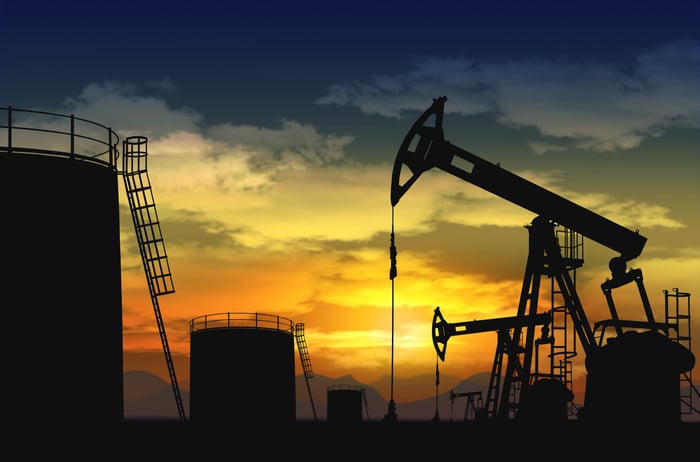Energy Transfer's (ET 0.56%) third-quarter results rebounded from a brutal second quarter as volumes bounced back thanks to improving market conditions. Because of that, the energy company expected to achieve the high end of its revised earnings guidance range. However, market conditions remain challenging, which led the MLP to slash its distribution by 50% during the quarter to reduce debt quicker.
Drilling down into Energy Transfer's third-quarter results
|
Metric |
Q3 2020 |
Q3 2019 |
Change YOY |
|---|---|---|---|
|
Adjusted EBITDA |
$2.866 billion |
$2.812 billion |
1.9% |
|
Distributable cash flow (DCF) |
$1.691 billion |
$1.546 billion |
9.4% |
|
DCF per unit |
$0.63 |
$0.59 |
6.8% |
|
Distribution coverage ratio |
4.1 times |
1.91 times |
114.7% |
Data source: Energy Transfer. YOY = year over year.
Energy Transfer's diversification paid dividends during the third quarter as its earnings and cash flow rebounded. Fueling the improvement were stronger results in its midstream and natural gas liquids (NGL) and refined products segments, which offset weakness elsewhere:

Data source: Energy Transfer. Chart by author.
Midstream earnings jumped 29% due in large part to the restructuring of certain gathering and processing agreements in the Ark-La-Tex region, which enabled it to recognize $75 million of deferred revenue. The company also benefited from lower operating expenses, which helped offset lower volumes in the south Texas region.
Earnings from the company's NGL and refined products assets improved by 14%. The major drivers were higher NGL volumes on its Mariner East pipeline system and its Texas NGL pipeline system. That helped offset weaker refined products transportation volumes due to a refinery outage and weaker demand for jet fuel and other refined products due to the pandemic.
Those positives helped to more than offset continued weakness in the company's crude oil and gas pipeline segments. Oil volumes in Texas and the Bakken remained lower due to weaker oil prices and refinery utilization as a result of COVID-19. Meanwhile, contract adjustments, bad debt expenses, and lower natural gas sales gains impacted its interstate and intrastate gas pipeline operations.

Image source: Getty Images.
A look at what's ahead for Energy Transfer
Thanks to its solid showing during the third quarter, and the overall improvement in the energy market from its low in the second quarter, Energy Transfer now expects its full-year adjusted EBITDA to be at the high end of its $10.2 billion to $10.5 billion range. That implies a roughly 6% decline from last year's level.
Meanwhile, Energy Transfer reduced its growth spending outlook once again. It now expects to invest $3.3 billion this year, which is more than $100 million below its last estimate and 18% less than its initial forecast. Meanwhile, the company anticipates that it will only spend $1.3 billion on capital projects next year, which is 28% below its original forecast. It sees capital spending further declining to a range of $500 million to $700 million per year in 2022 and 2023.
With capital spending coming down, Energy Transfer expects to generate excess cash next year after funding its recently reduced distribution. That will enable it to accelerate its debt reduction program to quickly achieve its leverage target of four to 4.5 times debt-to-EBITDA.
The company is also taking steps toward a cleaner future. The MLP currently gets 20% of its power from renewable energy. Meanwhile, it recently agreed to a power purchase agreement that will support a 28-megawatt solar energy project to supply it with clean power.
A step in the right direction
Energy Transfer's earnings bounced back during the third quarter as volumes recovered. However, market conditions remain challenging due to low oil prices. Because of that and the increasingly uncertain future for fossil fuels due to the shift toward renewable energy, the company halved its dividend to accelerate debt reduction. That move should help put its finances on a firmer foundation much sooner, which would then free that cash up to create value in other ways, including unit repurchases, a higher distribution, or acquisitions.





